Leg Side Mehndi Design Simple And Easy
Mehndi on the leg side adds an elegant twist to traditional hand and arm patterns, giving your overall look a touch of uniqueness. Whether you’re preparing for a wedding, festival, or just want a chic design for a casual occasion, leg side mehndi designs can be both striking and surprisingly simple to create. In this comprehensive guide, we’ll explore the Top 10 Leg Side Mehndi Designs that are simple and easy to master, complete with step-by-step tips, pattern breakdowns, and styling advice. Let’s get started!
Introduction to Leg Side Mehndi
Leg side mehndi, often referred to as anklet mehndi or foot-side mehndi, emphasizes flowing patterns along the calf and outer ankle rather than covering the entire foot. This style is perfect for those who want a subtle yet standout look—great for showing off a beautiful pair of sandals or heels.
Why Choose Leg Side Mehndi?
- Versatility: Complements both Western and traditional outfits.
- Comfort: Less bulky than full-foot coverage, allowing you to move freely.
- Uniqueness: Offers a modern spin on classic designs.
H2: Design #1 – Floral Vine Trail
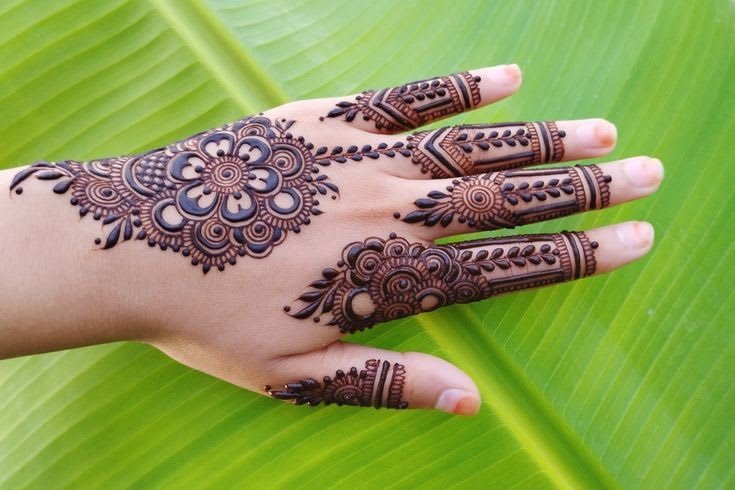
H3: Pattern Description
A winding vine adorned with small blossoms creates a graceful trail from ankle to mid-calf. The curvature of the vine accentuates the natural lines of your leg.
H3: Materials Needed
- Standard mehndi cone (fine tip)
- Tissue for blotting
H3: Step-by-Step Guide
- Start at the ankle: Draw a small spiral as the vine’s base.
- Extend the vine: Create gentle ‘S’-shaped curves upward.
- Add blossoms: At regular intervals, draw five-petal flowers branching off.
- Detailing: Fill petals with fine dots and add tiny leaves along the vine.
- Finishing touches: Outline the vine with a single-dot border for emphasis.
H2: Design #2 – Geometric Armband Accent
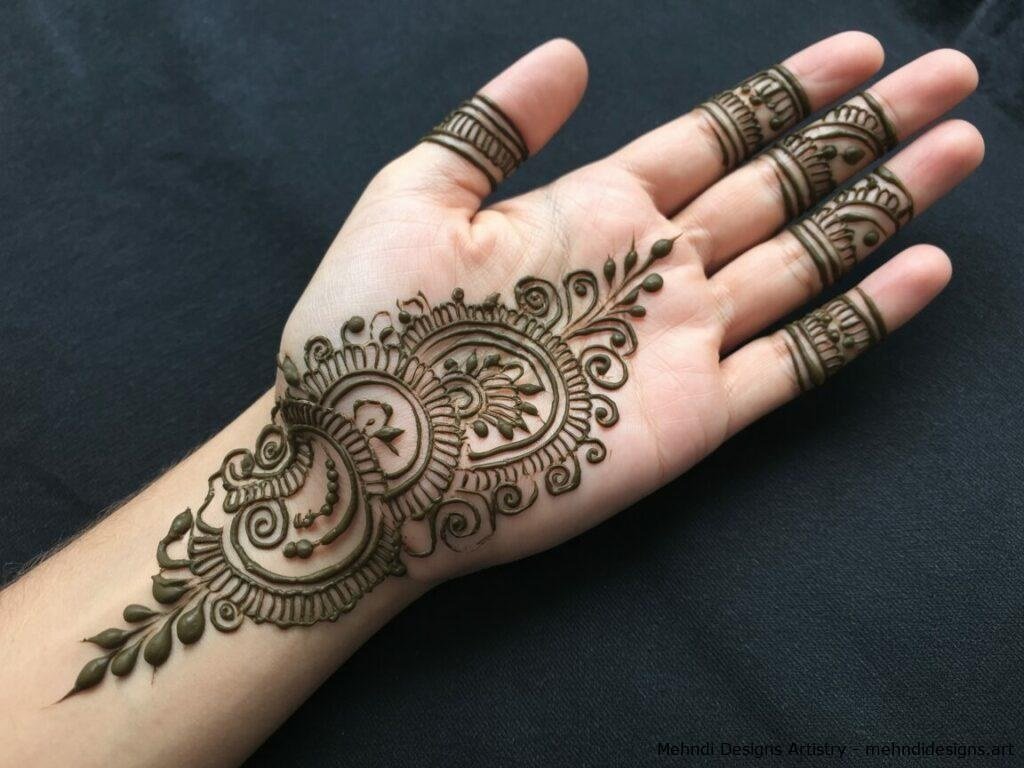
H3: Pattern Description
Inspired by contemporary jewelry, this design features horizontal bands of triangles, squares, and dots circling the leg side like an anklet bracelet.
H3: Materials Needed
- Mehndi cone with slightly thicker tip (for bolder lines)
- Ruler (optional, to keep lines straight)
H3: Step-by-Step Guide
- Measure your bands: Mark three parallel horizontal lines.
- First band – Triangles: Fill the space between lines with alternating triangle rows.
- Second band – Dots: Place evenly spaced dots.
- Third band – Squares: Draw small squares connected by thin lines.
- Detail edges: Add a row of micro-dots above and below each band for definition.
H2: Design #3 – Paisley Cascade
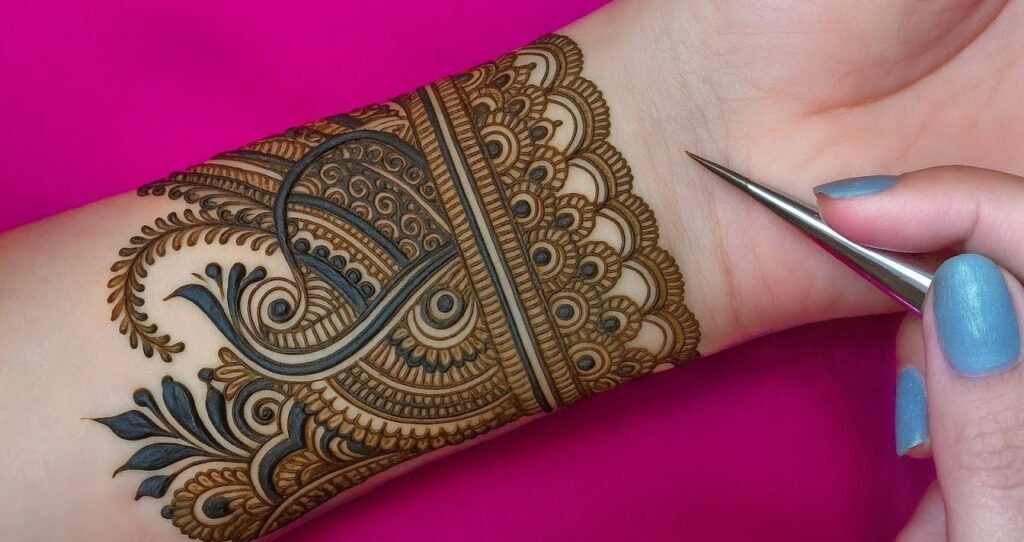
H3: Pattern Description
The classic paisley motif cascades in a diagonal flow down the leg side, creating a dynamic and timeless look.
H3: Materials Needed
- Fine-tip mehndi cone
- Toothpick (for precision corrections)
H3: Step-by-Step Guide
- Base paisley: Draw a large paisley shape near the ankle.
- Secondary paisleys: Add smaller paisleys radiating upward.
- Fill patterns: Inside each paisley, include teardrops, dots, and mini-florals.
- Connecting swirls: Use curved lines to link all paisleys.
- Embellishments: Sprinkle clusters of tiny dots to fill gaps.
H2: Design #4 – Mandala Spotlight
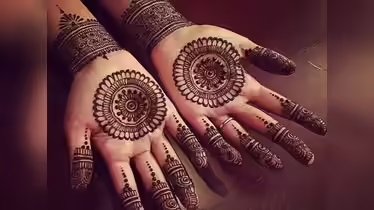
H3: Pattern Description
A single mandala—full of concentric circles, petals, and dots—serves as the focal point on the calf, surrounded by minimalist vines.
H3: Materials Needed
- Mehndi cone with adjustable flow
- Compass stencil (optional)
H3: Step-by-Step Guide
- Central dot: Place a medium-sized dot as mandala’s center.
- First circle: Draw a thin ring around the dot.
- Petal layer: Sketch evenly spaced petals.
- Outer details: Add scalloped edges, then a ring of micro-dots.
- Vine accents: From mandala edges, draw two slender vines flowing diagonally.
H2: Design #5 – Lace-Style Mesh
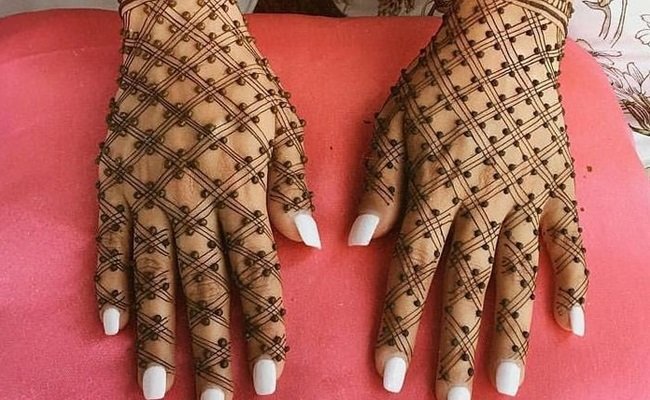
H3: Pattern Description
A delicate net-like pattern that mimics lace overlays the leg side, giving a sophisticated, bridal-inspired appearance.
H3: Materials Needed
- Very fine-tip mehndi cone
- Pencil for initial grid (optional)
H3: Step-by-Step Guide
- Create a grid: Lightly outline diagonal lines forming diamonds.
- Mesh lines: Trace over the grid with mehndi, making lines slightly curved.
- Embellish intersections: At every diamond vertex, place a tiny flower or dot.
- Framing band: At top and bottom, draw scalloped edging to contain the mesh.
- Clean-up: Remove any pencil marks and perfect the curves with a toothpick.
H2: Design #6 – Minimalist Dot-and-Line
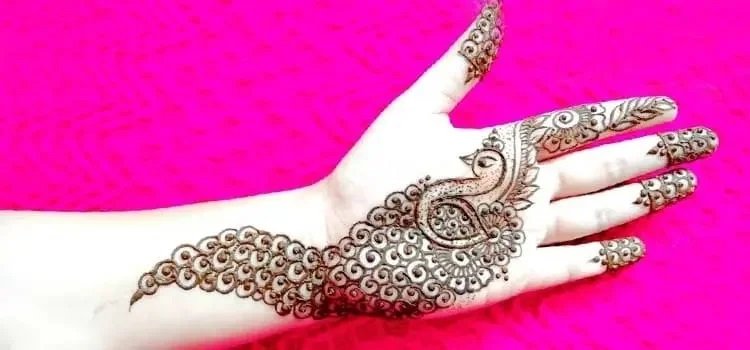
H3: Pattern Description
For an ultra-simple look, use linear arrangements of dots and fine lines that travel in parallel or intersecting formations.
H3: Materials Needed
- Extra-fine mehndi cone
- Patience for precision
H3: Step-by-Step Guide
- Mark anchor points: Lightly spot with white eyeliner to guide your pattern.
- Draw parallel lines: Lay down two to three thin lines.
- Connect with dots: At intervals, join lines with single or clustered dots.
- Add peekaboo elements: Between lines, add a small dash or tiny leaf.
- Balance the spacing: Ensure uniformity by measuring visually from one end to the other.
H3: Pattern Description
Inspired by feather motifs, brush-like strokes curve gently, giving an airy, romantic feel.
H3: Materials Needed
- Fine-tip mehndi cone
- Scrap paper to test strokes
H3: Step-by-Step Guide
- Central spine: Draw a slender curved line as the feather’s shaft.
- Barbs creation: From the spine, sketch fine angled lines alternating on both sides.
- Feather tip: Taper off the spine with a small swirl.
- Shadow dots: Place tiny dots along the spine to add depth.
- Repeat variation: Create two more feathers of varying sizes for a layered look.
H2: Tips for Perfecting Leg Side Mehndi
- Prep your skin: Clean and exfoliate the area to remove oils and dead skin.
- Steady hand: Rest your elbow on a stable surface while applying.
- Drying time: Allow 3–4 hours of drying; wrap lightly in tissue if needed overnight.
- Aftercare: Avoid water for at least 12 hours post-application. Apply a mixture of lemon juice and sugar to seal the design.
Table of Contents
Conclusion
Leg side mehndi designs offer a fresh, modern take on traditional body art. From simple dot-and-line minimalism to intricate paisley cascades and Kundan-inspired motifs, there’s a design on this list for every skill level. Practice each of these Top 10 patterns to find your signature style, and don’t be afraid to mix elements—an unexpected twist often makes the most memorable designs. Happy mehndi-ing!
Also read Top 10 Mehndi Design for Engagement: Elegant and Trendy Styles for Brides-to-Be


